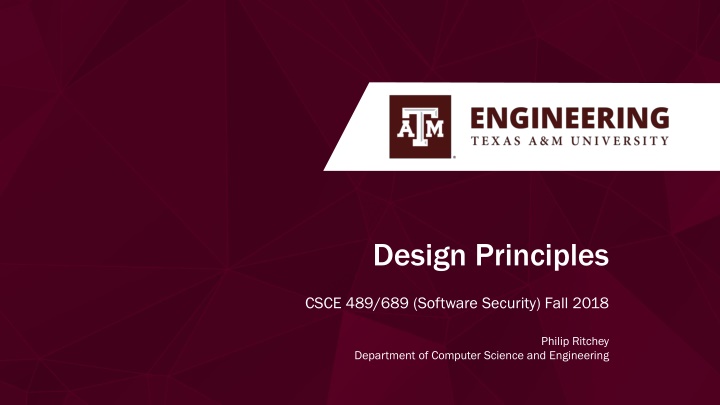
Understanding Software Security Design Principles
Explore the fundamental design principles that guide security decisions in software development. Learn about concepts such as least privilege, complete mediation, and economy of mechanism to create secure and robust systems rooted in simplicity and restriction.
Download Presentation

Please find below an Image/Link to download the presentation.
The content on the website is provided AS IS for your information and personal use only. It may not be sold, licensed, or shared on other websites without obtaining consent from the author. If you encounter any issues during the download, it is possible that the publisher has removed the file from their server.
You are allowed to download the files provided on this website for personal or commercial use, subject to the condition that they are used lawfully. All files are the property of their respective owners.
The content on the website is provided AS IS for your information and personal use only. It may not be sold, licensed, or shared on other websites without obtaining consent from the author.
E N D
Presentation Transcript
Design Principles CSCE 489/689 (Software Security) Fall 2018 Philip Ritchey Department of Computer Science and Engineering CSCE 489/689 (Software Security) Fall 2018 1
If you remember nothing else Design principles are guides to making design decisions Security design principles guide security design decisions Security Design Principles are rooted in simplicity and restriction All of the design principles are important but I will never forgive you if you don t remember these: Least privilege Complete mediation Economy of mechanism Work factor Work factor CSCE 489/689 (Software Security) Fall 2018 2
https://xkcd.com/2030/ CSCE 489/689 (Software Security) Fall 2018 3
https://twitter.com/neiltyson/status/551378648578916353?lang=enhttps://twitter.com/neiltyson/status/551378648578916353?lang=en CSCE 489/689 (Software Security) Fall 2018 5
The Basics: Design Principles Simplicity Simplicity Less to go wrong Fewer possible inconsistencies Easy to understand Restriction Restriction Minimize access Inhibit communication CSCE 489/689 (Software Security) Fall 2018 6
The Basics: Design Principles Least privilege Least privilege: Every program and every user of the system should operate using the least set of privileges necessary to complete the job. Complete mediation Complete mediation: Every access to every object must be checked for authority. Fail Fail- -safe defaults safe defaults: Base access decisions on permission rather than exclusion. Economy of mechanism Economy of mechanism: Keep the design as simple and small as possible. Separation of privilege Separation of privilege: Where feasible, a protection mechanism that requires two keys to unlock it is more robust and flexible than one that allows access to the presenter of only a single key. CSCE 489/689 (Software Security) Fall 2018 7
The Basics: Design Principles Open design Open design: The design should not be secret. Least common mechanism Least common mechanism: Minimize the amount of mechanism common to more than one user and depended on by all users. Psychological acceptability Psychological acceptability: It is essential that the human interface be designed for ease of use, so that users routinely and automatically apply the protection mechanisms correctly. Work factor Work factor: Compare the cost of circumventing the mechanism with the resources of a potential attacker. Compromise recording Compromise recording: It is sometimes suggested that mechanisms that reliably record that a compromise of information has occurred can be used in place of more elaborate mechanisms that completely prevent loss. CSCE 489/689 (Software Security) Fall 2018 8
Least Privilege A subject should be given only those privileges necessary to complete its task Function, not identity, controls Rights added as needed, discarded after use Minimal protection domain CSCE 489/689 (Software Security) Fall 2018 9
Complete Mediation Check every Usually done once, on first action UNIX: access checked on open, not checked thereafter This is not not secure If permissions change after, may get unauthorized access every access CSCE 489/689 (Software Security) Fall 2018 10
Fail-Safe Defaults Default action is to deny access If action fails, system as secure as when action began CSCE 489/689 (Software Security) Fall 2018 11
Economy of Mechanism Keep it as simple as possible KISS Principle Simpler means less can go wrong And when errors occur, they are easier to understand and fix Interfaces and interactions CSCE 489/689 (Software Security) Fall 2018 12
Open Design Security should not depend on secrecy of design or implementation Popularly misunderstood to mean that source code should be public Security through obscurity is no security at all Does not apply to information such as passwords or cryptographic keys Assume the attacker has perfect knowledge Then obscure all you want CSCE 489/689 (Software Security) Fall 2018 13
Separation of Privilege Require multiple conditions to grant privilege Separation of duty Defense in depth CSCE 489/689 (Software Security) Fall 2018 14
Least Common Mechanism Mechanisms should not be shared Information can flow along shared channels Covert channels Isolation Virtual machines Sandboxes CSCE 489/689 (Software Security) Fall 2018 15
Psychological Acceptability Security mechanisms should not add to difficulty of accessing resource Hide complexity introduced by security mechanisms Ease of installation, configuration, use Human factors critical here CSCE 489/689 (Software Security) Fall 2018 16
Work Factor Make it more expensive (time & effort) to successfully attack the system than the reward for a successful attack. Defense in depth has multiplicative effect on work factor: must find exploit(s) that can get past all levels of defenses Make explicit assumptions about attacker capabilities and motivation Balance cost of defense against value of assets. 100% security not possible Prioritize threats CSCE 489/689 (Software Security) Fall 2018 17
Compromise Recording Auditing: keep an append-only, tamper-resistant log of events in a secure location. Append-only: no editing or deleting impossible(?) to cover tracks Tamper-resistant: require authentication and authorization to append AND detect unauthorized appends Secure location: do not put it in the same place as other data, keep backups in another secure location Incident response relies on accurate records of events Can also help in troubleshooting and debugging CSCE 489/689 (Software Security) Fall 2018 18
Thanks and Gig em! WHOOP! CSCE 489/689 (Software Security) Fall 2018 19
